Article 370 Case : Summary Of Petitioners' Arguments Before Supreme Court
Padmakshi Sharma
24 Aug 2023 1:07 PM IST

Next Story
24 Aug 2023 1:07 PM IST
After an exhaustive span of nine days dedicated to hearings, the petitioners have drawn the curtains on their arguments in the batch of pleas challenging the dissolution of Jammu and Kashmir's special status under Article 370. The Constitution bench of the Supreme Court, led by Chief Justice of India DY Chandrachud and composed of Justices Sanjay Kishan Kaul, Sanjiv Khanna, BR Gavai, and...
